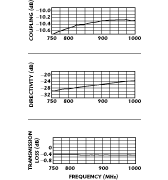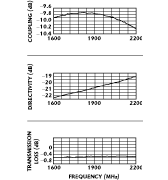Quadrature Hybrids and Directional Couplers for Telecom Applications
Sage Laboratories Inc.
Natick, MA
Traditional couplers and hybrids have been manufactured using stripline, microstrip, airline, transverse electromagnetic line and waveguide technologies, and have been driven primarily by the military and low volume test set markets. As such, these devices have focused on the stringent environmental, electrical and mechanical requirements of the military’s qualified parts list, making them relatively high priced and high performance.
Today’s high volume telecommunications base station market demands proven cost-effective performance and built-in reliability from standard, off-the-shelf components. The TELEPAC™ series 90° quadrature hybrids and directional couplers are designed specifically to address the sampling and monitoring needs of the current telecommunications system base station manufacturers. The new series of couplers and hybrids is aimed at the 800 to 960 MHz and 1700 to 2100 MHz telecommunications bands and incorporates the patented WIREPAC® twin-conductor line technology. This type of configuration features a robust mechanical construction and ease of manufacturing while offering optimum electrical performance. The new line incorporates many of the performance and processing advantages gained from years of manufacturing experience with conventional stripline and microstrip couplers and hybrids as well as from WIRELINE® and WIREPAC drop-in devices.
Description
The core products of the TELEPAC line are listed in Table 1 and serve as a base line to illustrate the total product capabilities. Two frequency bands, 800 to 960 MHz and 1700 to 2100 MHz, allow for cellular and personal communications service (PCS) applications. The units have a high power-handling capability to satisfy both transmit and receive applications. The devices are available in popular coupling values including 3, 4.8, 6, 10, 20 and 30 dB. In addition, custom variations of these products can be generated easily to satisfy specific customer needs.
|
Table 1 -- Standard Telepac Couplers and Hybrids | |||
|
Model |
Coupling (dB) |
Frequency Range (MHz) |
Connector Type |
|
Quadrature Hybrids |
|
|
|
|
THN-09-03 |
3 |
800 to 960 |
N |
|
THN-20-03 |
3 |
1700 to 2100 |
N |
|
Directional Couplers |
|
|
|
|
TCN-09-03 |
3 |
800 to 960 |
N |
|
TCN-20-03 |
3 |
1700 to 2100 |
N |
|
TCN-09-06 |
6 |
800 to 960 |
N |
|
TCN-20-06 |
6 |
1700 to 2100 |
N |
|
TCN-09-10 |
10 |
800 to 960 |
N |
|
TCN-20-10 |
10 |
1700 to 2100 |
N |
|
TCN-09-20 |
20 |
800 to 960 |
N |
|
TCN-20-20 |
20 |
1700 to 2100 |
N |
|
TCN-09-30 |
30 |
800 to 960 |
N |
|
TCN-20-30 |
30 |
1700 to 2100 |
N |
Figure 1 shows the performance of a 10 dB cellular directional coupler.  The coupling tolerance is specified to be ±1 dB (max), directivity is > 18 dB and transmission loss is –0.5 dB (max). Figures 2 and 3 show data for 10 and 20 dB PCS directional couplers, respectively. The specifications for these devices include a ±1 dB coupling tolerance; > 18 dB directivity; and 0.6 dB and 0.25 dB (max) transmission loss, respectively. The return losses for all ports are > –18 dB for each coupler.
The coupling tolerance is specified to be ±1 dB (max), directivity is > 18 dB and transmission loss is –0.5 dB (max). Figures 2 and 3 show data for 10 and 20 dB PCS directional couplers, respectively. The specifications for these devices include a ±1 dB coupling tolerance; > 18 dB directivity; and 0.6 dB and 0.25 dB (max) transmission loss, respectively. The return losses for all ports are > –18 dB for each coupler.
Type-N connectors are preferred by telecommunications infrastructure manufacturers and installers not for power handling predominantly,  but for durability. The TELEPAC products incorporate type-N connectors mounted onto block aluminum housings, creating a tough package that will survive the extremes of transportation and installation at remote site locations. In addition, SMA and TNC connectors can be specified. Couplers are available in either in-line or directional configurations while the hybrids are available in standard H configurations.
but for durability. The TELEPAC products incorporate type-N connectors mounted onto block aluminum housings, creating a tough package that will survive the extremes of transportation and installation at remote site locations. In addition, SMA and TNC connectors can be specified. Couplers are available in either in-line or directional configurations while the hybrids are available in standard H configurations.
Other specifications include a coupling tolerance of ±0.5 dB for all coupling values except ±1 dB for the 30 dB coupler. Coupling stability is ±0.3 dB. Input/output return loss is 18 dB (min), directivity is 18 dB (min) and power handling is 250 W (max). Typical housing dimensions including type-N connectors are 3.5" ¥ 1.0" ¥ 1.2" for the low frequency band and 2.4" ¥ 1.0" ¥ 1.2" for the high frequency band. 
Applications
Typically, these couplers are used to monitor and sample RF power and return loss between antennas and transmitters/receivers associated with cellular and PCS base stations, minicells and microcells. The hybrids are used in power combining and dividing associated with power amplifiers and also in lieu of electromechanical switches to transfer power between the transmitter and receiver and the antenna.
Conclusion
The TELEPAC hybrids and couplers are designed to maintain a high level of reliability while reducing overall installation cost to the system supplier. With unit prices as low as $65 in volume production, the demand of lower system bill-of-material costs can be met. Specific model prices can be obtained on request. Lead time for standard products is stock to 30 days (ARO). Lead time for custom products is from 30 to 90 days. Working samples are available for qualified applications.
Sage Laboratories Inc ., Natick, MA (508) 653-0844.
